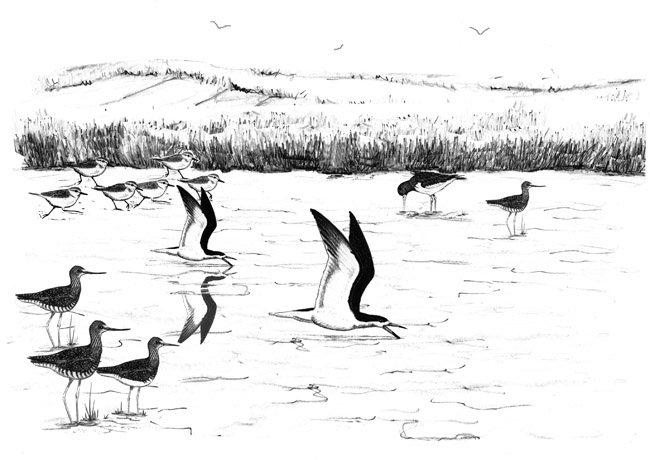
The Birds of Monomoy II,
Last week, Roger wanted to know about birding on the Monomoy Wildlife Refuge. Instead of answering him, I turned the entire column into being about me. I told him how two people had donated a total of $5,000 to Mass Audubon’s Wellfleet Bay Wildlife Sanctuary so they could take a birding trip to South Monomoy Island with, of all people, me. Sanctuary director, Bob Prescott, led the trip because I really don’t know a thing about Monomoy and Bob knows more about it than Chuck E. knows about cheese. By the end of last week’s column our boat had just arrived near an area on South Monomoy called the “Powder Hole,” which was filled with a whole assortment of birds. Here’s what we saw.
I think the metaphor most often used when adults come face-to-face with too many good choices is: “We were like kids in a candy store.” That’s what the Powder Hole was like. There were birds everywhere. But unlike a candy store, where the candy simply sits peacefully on the shelves and doesn’t move (except for maybe Pop Rocks), birds are in a constant state of motion. All around us birds were flying, landing, feeding and chasing each other. As we took in this magnificent spectacle, everyone became very quiet. Well, everyone except for one annoying guy who kept asking: “Bob, what is this bird?” “How about this one?” “Hey, Bob, did you see that?” The guy was so irritating Bob finally had to ask me to be quiet.
The first bird I locked onto was a Black Tern. Black Terns aren’t like the “white” terns we usually see around here. During the breeding season these terns have black heads and bodies, plus soft gray wings, looking like a cross between a crow, a catbird and a funeral director. Also, unlike other terns that hunt by violently plunging into the water, Black Terns are daintier. Instead of all the crashing and splashing, these birds gather prey by delicately plunking food off the waters’ surface. They breed in northern Canada, winter in the tropics, and only stop on Cape Cod during their fall migration. August is a good time to see Black Terns, but they are typically only seen in small numbers and in out-of-the-way places, such as South Monomoy. The Black Terns alone made the trip worth the price…at least for me, because I didn’t pay anything.
As I stared at the terns, I heard someone yell, “There’s a skimmer!” With their lower bill considerably longer than their top bill, Black Skimmers are odd, but distinctive-looking birds. This particular skimmer was sound asleep and had its beak tucked under its feathers. Bob said that the last time he was at the Powder Hole the skimmers were also sleeping and never woke up during the entire visit. (I guess the skimmers don’t find Bob as interesting as the rest of us do.) Just as he said those words, the skimmer popped its head up and showed off its famous beak. And then, as if to make up for sleeping on the job last time, this skimmer took to the air and started feeding in its unique style. As their name implies, skimmers survive by skimming, but not the politician kind of skimming. When hunting, the birds fly just above the water’s surface, dragging their lower bill as they go, in hopes of snapping up an unlucky fish. We watched the bird fly back and forth for quite a while, slicing the water with its bill as it flew. It looked like a tough way to earn a living. No wonder they do so much sleeping.
When the skimmer show ended I focused my scope on a sandpiper that was towering above all the others. It was a Hudsonian Godwit. Godwits are large shorebirds with long, slightly upturned bills. For years Hudsonian Godwits were considered to be extremely rare, due to the fact that hardly any of them were seen each year. Then it was discovered why so few of them were seen. It turns out godwits, which breed in the high Arctic, often fly nonstop to their wintering grounds in South America, bypassing most of North America altogether. The few godwits seen in the fall are birds that must stop to rest because of bad weather or laziness. Like the Black Tern, Monomoy is reliable place to see these jumbo sandpipers.
In addition to the birds I’ve mentioned, we also saw many other species of shorebirds, terns, swallows, a few oystercatchers and lots of Salt Marsh Sparrows, that no one else except me seemed interested in looking at. After two short hours of wading among the birds of South Monomoy, Bob announced that it was time to head back to the boat. This was the first time all day I didn’t like what Bob had to say, so I pretended not to hear him. Then it occurred to me, the trip was over and Mass Audubon had the money. Bob didn’t care if I made the return trip home or not. So I reluctantly climbed into the boat, but I wasn’t happy about it.
Monomoy is a great place to take your friend, Roger, but access is limited. There are a few charter services that ferry groups over, but for individuals I recommend signing up for one of Mass Audubon’s trips (one of their “non- $5,000” trips). Mass Audubon provides excellent naturalists who really know their stuff. I’d also like to say that I very much appreciate the folks from the auction who paid for the trip, which for some reason included me. I also appreciate Bob, and the folks at Mass Audubon who tricked me into going. Little do they know that when it comes to a trip to South Monomoy, they can trick me anytime they want.